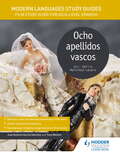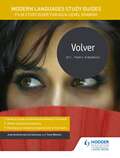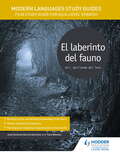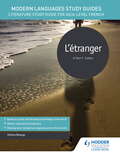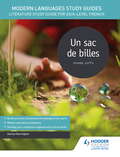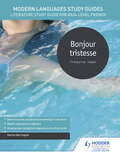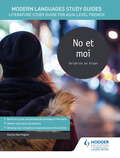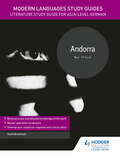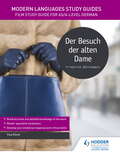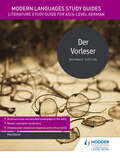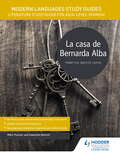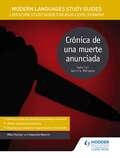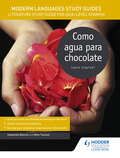- Table View
- List View
Modern Languages Study Guides: Film Study Guide for AS/A-level Spanish
by Tony Weston José García SánchezFilm analysis made easy. Build your students' confidence in their language abilities and help them develop the skills needed to critique their chosen work: putting it into context, understanding the themes and director's technique, as well as specialist terminology.Breaking down each scene, character and theme in Ocho apellidos vascos, this accessible guide will enable your students to understand the historical and social context of the film and give them the critical and language skills needed to write a successful essay.- Strengthen language skills with relevant grammar, vocab and writing exercises throughout- Aim for top marks by building a bank of textual examples and quotes to enhance exam response- Build confidence with knowledge-check questions at the end of every chapter- Revise effectively with pages of essential vocabulary and key mind maps throughout- Feel prepared for exams with advice on how to write an essay, plus sample essay questions, two levels of model answers and examiner commentary
Modern Languages Study Guides: Film Study Guide for AS/A-level Spanish
by Tony Weston José García SánchezFilm analysis made easy. Build your students' confidence in their language abilities and help them develop the skills needed to critique their chosen work: putting it into context, understanding the themes and director's technique, as well as specialist terminology.Breaking down each scene, character and theme in Volver, this accessible guide will enable your students to understand the historical and social context of the film and give them the critical and language skills needed to write a successful essay.- Strengthen language skills with relevant grammar, vocab and writing exercises throughout- Aim for top marks by building a bank of textual examples and quotes to enhance exam response- Build confidence with knowledge-check questions at the end of every chapter- Revise effectively with pages of essential vocabulary and key mind maps throughout- Feel prepared for exams with advice on how to write an essay, plus sample essay questions, two levels of model answers and examiner commentary
Modern Languages Study Guides: Film Study Guide for AS/A-level Spanish
by Tony Weston José García SánchezFilm analysis made easy. Build your students' confidence in their language abilities and help them develop the skills needed to critique their chosen work: putting it into context, understanding the themes and director's technique, as well as specialist terminology.Breaking down each scene, character and theme in El laberinto del fauno, this accessible guide will enable your students to understand the historical and social context of the film and give them the critical and language skills needed to write a successful essay.- Strengthen language skills with relevant grammar, vocab and writing exercises throughout- Aim for top marks by building a bank of textual examples and quotes to enhance exam response- Build confidence with knowledge-check questions at the end of every chapter- Revise effectively with pages of essential vocabulary and key mind maps throughout- Feel prepared for exams with advice on how to write an essay, plus sample essay questions, two levels of model answers and examiner commentary
Modern Languages Study Guides: Film Study Guide for AS/A-level Spanish (Film and literature guides)
by Tony Weston José Antonio SánchezExam Board: AQALevel: AS/A-levelSubject: Modern LanguagesFirst Teaching: September 2017First Exam: June 2018Film analysis made easy. Build your students' confidence in their language abilities and help them develop the skills needed to critique their chosen work: putting it into context, understanding the themes and director's technique, as well as specialist terminology.Breaking down each scene, character and theme in Ocho apellidos vascos (Spanish Affair), this accessible guide will enable your students to understand the historical and social context of the film and give them the critical and language skills needed to write a successful essay.- Strengthen language skills with relevant grammar, vocab and writing exercises throughout- Aim for top marks by building a bank of textual examples and quotes to enhance exam response- Build confidence with knowledge-check questions at the end of every chapter- Revise effectively with pages of essential vocabulary and key mind maps throughout- Feel prepared for exams with advice on how to write an essay, plus sample essay questions, two levels of model answers and examiner commentary
Modern Languages Study Guides: Film Study Guide for AS/A-level Spanish (Film and literature guides)
by Tony Weston José Antonio SánchezExam Board: AQA, Edexcel & WJECLevel: AS/A-levelSubject: Modern LanguagesFirst Teaching: September 2017First Exam: June 2018Film analysis made easy. Build your students' confidence in their language abilities and help them develop the skills needed to critique their chosen work: putting it into context, understanding the themes and director's technique, as well as specialist terminology.Breaking down each scene, character and theme in Volver, this accessible guide will enable your students to understand the historical and social context of the film and give them the critical and language skills needed to write a successful essay.- Strengthen language skills with relevant grammar, vocab and writing exercises throughout- Aim for top marks by building a bank of textual examples and quotes to enhance exam response- Build confidence with knowledge-check questions at the end of every chapter- Revise effectively with pages of essential vocabulary and key mind maps throughout- Feel prepared for exams with advice on how to write an essay, plus sample essay questions, two levels of model answers and examiner commentary
Modern Languages Study Guides: Film Study Guide for AS/A-level Spanish (Film and literature guides)
by Tony Weston José Antonio SánchezExam Board: AQA, Edexcel & EduqasLevel: AS/A-levelSubject: Modern LanguagesFirst Teaching: September 2017First Exam: June 2018Film analysis made easy. Build your students' confidence in their language abilities and help them develop the skills needed to critique their chosen work: putting it into context, understanding the themes and director's technique, as well as specialist terminology.Breaking down each scene, character and theme in El laberinto del fauno (Pan's Labyrinth), this accessible guide will enable your students to understand the historical and social context of the film and give them the critical and language skills needed to write a successful essay.- Strengthen language skills with relevant grammar, vocab and writing exercises throughout- Aim for top marks by building a bank of textual examples and quotes to enhance exam response- Build confidence with knowledge-check questions at the end of every chapter- Revise effectively with pages of essential vocabulary and key mind maps throughout- Feel prepared for exams with advice on how to write an essay, plus sample essay questions, two levels of model answers and examiner commentary
Modern Languages Study Guides: Literature Study Guide for AS/A-level French
by Hélène BeaugyLiterature analysis made easy. Build your students' confidence in their language abilities and help them develop the skills needed to critique their chosen work: putting it into context, understanding the themes and narrative technique, as well as specialist terminology.Breaking down each scene, character and theme in L'étranger, this accessible guide will enable your students to understand the historical and social context of the novel and give them the critical and language skills needed to write a successful essay.- Strengthen language skills with relevant grammar, vocab and writing exercises throughout- Aim for top marks by building a bank of textual examples and quotes to enhance exam response- Build confidence with knowledge-check questions at the end of every chapter- Revise effectively with pages of essential vocabulary and key mind maps throughout- Feel prepared for exams with advice on how to write an essay, plus sample essay questions, two levels of model answers and examiner commentary
Modern Languages Study Guides: Literature Study Guide for AS/A-level French
by Karine HarringtonExam Board: AQA, Edexcel, OCR & WJECLevel: AS/A-levelSubject: Modern LanguagesFirst Teaching: September 2016First Exam: June 2017Literature analysis made easy. Build your students' confidence in their language abilities and help them develop the skills needed to critique their chosen work: putting it into context, understanding the themes and narrative technique, as well as specialist terminology.Breaking down each scene, character and theme in Un Sac de Billes (A Bag of Marbles), this accessible guide will enable your students to understand the historical and social context of the novel and give them the critical and language skills needed to write a successful essay.- Strengthen language skills with relevant grammar, vocab and writing exercises throughout- Aim for top marks by building a bank of textual examples and quotes to enhance exam response- Build confidence with knowledge-check questions at the end of every chapter- Revise effectively with pages of essential vocabulary and key mind maps throughout- Feel prepared for exams with advice on how to write an essay, plus sample essay questions, two levels of model answers and examiner commentary
Modern Languages Study Guides: Literature Study Guide for AS/A-level French
by Karine HarringtonLiterature analysis made easy. Build your students' confidence in their language abilities and help them develop the skills needed to critique their chosen work: putting it into context, understanding the themes and narrative technique, as well as specialist terminology.Breaking down each scene, character and theme in Bonjour tristesse (Hello sadness) this accessible guide will enable your students to understand the historical and social context of the novel and give them the critical and language skills needed to write a successful essay.- Strengthen language skills with relevant grammar, vocab and writing exercises throughout- Aim for top marks by building a bank of textual examples and quotes to enhance exam response- Build confidence with knowledge-check questions at the end of every chapter- Revise effectively with pages of essential vocabulary and key mind maps throughout- Feel prepared for exams with advice on how to write an essay, plus sample essay questions, two levels of model answers and examiner commentary
Modern Languages Study Guides: Literature Study Guide for AS/A-level French
by Karine HarringtonExam Board: AQA, Edexcel, OCR & WJECLevel: AS/A-levelSubject: Modern LanguagesFirst Teaching: September 2016First Exam: June 2017Literature analysis made easy. Build your students' confidence in their language abilities and help them develop the skills needed to critique their chosen work: putting it into context, understanding the themes and narrative technique, as well as specialist terminology.Breaking down each scene, character and theme in No et moi (No and Me), this accessible guide will enable your students to understand the historical and social context of the novel and give them the critical and language skills needed to write a successful essay.- Strengthen language skills with relevant grammar, vocab and writing exercises throughout- Aim for top marks by building a bank of textual examples and quotes to enhance exam response- Build confidence with knowledge-check questions at the end of every chapter- Revise effectively with pages of essential vocabulary and key mind maps throughout- Feel prepared for exams with advice on how to write an essay, plus sample essay questions, two levels of model answers and examiner commentary
Modern Languages Study Guides: Literature Study Guide for AS/A-level French
by Karine HarringtonLiterature analysis made easy. Build your students' confidence in their language abilities and help them develop the skills needed to critique their chosen work: putting it into context, understanding the themes and narrative technique, as well as specialist terminology.Breaking down each scene, character and theme in Bonjour tristesse (Hello sadness) this accessible guide will enable your students to understand the historical and social context of the novel and give them the critical and language skills needed to write a successful essay.- Strengthen language skills with relevant grammar, vocab and writing exercises throughout- Aim for top marks by building a bank of textual examples and quotes to enhance exam response- Build confidence with knowledge-check questions at the end of every chapter- Revise effectively with pages of essential vocabulary and key mind maps throughout- Feel prepared for exams with advice on how to write an essay, plus sample essay questions, two levels of model answers and examiner commentary
Modern Languages Study Guides: Literature Study Guide for AS/A-level French (Film and literature guides)
by Hélène BeaugyExam Board: AQA, Edexcel, Eduqas & CCEALevel: AS/A-levelSubject: Modern LanguagesFirst Teaching: September 2016First Exam: June 2017Literature analysis made easy. Build your students' confidence in their language abilities and help them develop the skills needed to critique their chosen work: putting it into context, understanding the themes and narrative technique, as well as specialist terminology.Breaking down each scene, character and theme in L'étranger (The Outsider), this accessible guide will enable your students to understand the historical and social context of the novel and give them the critical and language skills needed to write a successful essay.- Strengthen language skills with relevant grammar, vocab and writing exercises throughout- Aim for top marks by building a bank of textual examples and quotes to enhance exam response- Build confidence with knowledge-check questions at the end of every chapter- Revise effectively with pages of essential vocabulary and key mind maps throughout- Feel prepared for exams with advice on how to write an essay, plus sample essay questions, two levels of model answers and examiner commentary
Modern Languages Study Guides: Literature Study Guide for AS/A-level French (Film and literature guides)
by Karine HarringtonExam Board: AQA, Edexcel, Eduqas & CCEALevel: AS/A-levelSubject: Modern LanguagesFirst Teaching: September 2016First Exam: June 2017Literature analysis made easy. Build your students' confidence in their language abilities and help them develop the skills needed to critique their chosen work: putting it into context, understanding the themes and narrative technique, as well as specialist terminology.Breaking down each scene, character and theme in No et moi (No and Me), this accessible guide will enable your students to understand the historical and social context of the novel and give them the critical and language skills needed to write a successful essay.- Strengthen language skills with relevant grammar, vocab and writing exercises throughout- Aim for top marks by building a bank of textual examples and quotes to enhance exam response- Build confidence with knowledge-check questions at the end of every chapter- Revise effectively with pages of essential vocabulary and key mind maps throughout- Feel prepared for exams with advice on how to write an essay, plus sample essay questions, two levels of model answers and examiner commentary
Modern Languages Study Guides: Literature Study Guide for AS/A-level French (Film and literature guides)
by Karine HarringtonExam Board: AQA & EdexcelLevel: AS/A-levelSubject: Modern LanguagesFirst Teaching: September 2016First Exam: June 2017Literature analysis made easy. Build your students' confidence in their language abilities and help them develop the skills needed to critique their chosen work: putting it into context, understanding the themes and narrative technique, as well as specialist terminology.Breaking down each scene, character and theme in Un Sac de Billes (A Bag of Marbles), this accessible guide will enable your students to understand the historical and social context of the novel and give them the critical and language skills needed to write a successful essay.- Strengthen language skills with relevant grammar, vocab and writing exercises throughout- Aim for top marks by building a bank of textual examples and quotes to enhance exam response- Build confidence with knowledge-check questions at the end of every chapter- Revise effectively with pages of essential vocabulary and key mind maps throughout- Feel prepared for exams with advice on how to write an essay, plus sample essay questions, two levels of model answers and examiner commentary
Modern Languages Study Guides: Literature Study Guide for AS/A-level German
by Geoff BrammallLiterature analysis made easy. Build your students' confidence in their language abilities and help them develop the skills needed to critique their chosen work: putting it into context, understanding the themes and narrative technique, as well as specialist terminology.Breaking down each scene, character and theme in Andorra, this accessible guide will enable your students to understand the historical and social context of the novel and give them the critical and language skills needed to write a successful essay.- Strengthen language skills with relevant grammar, vocab and writing exercises throughout- Aim for top marks by building a bank of textual examples and quotes to enhance exam response- Build confidence with knowledge-check questions at the end of every chapter- Revise effectively with pages of essential vocabulary and key mind maps throughout- Feel prepared for exams with advice on how to write an essay, plus sample essay questions, two levels of model answers and examiner commentary
Modern Languages Study Guides: Literature Study Guide for AS/A-level German
by Geoff BrammallLiterature analysis made easy. Build your students' confidence in their language abilities and help them develop the skills needed to critique their chosen work: putting it into context, understanding the themes and narrative technique, as well as specialist terminology.Breaking down each scene, character and theme in Andorra, this accessible guide will enable your students to understand the historical and social context of the novel and give them the critical and language skills needed to write a successful essay.- Strengthen language skills with relevant grammar, vocab and writing exercises throughout- Aim for top marks by building a bank of textual examples and quotes to enhance exam response- Build confidence with knowledge-check questions at the end of every chapter- Revise effectively with pages of essential vocabulary and key mind maps throughout- Feel prepared for exams with advice on how to write an essay, plus sample essay questions, two levels of model answers and examiner commentary
Modern Languages Study Guides: Literature Study Guide for AS/A-level German
by Paul ElliottLiterature analysis made easy. Build your students' confidence in their language abilities and help them develop the skills needed to critique their chosen work: putting it into context, understanding the themes and narrative technique, as well as specialist terminology.Breaking down each scene, character and theme in Der Besuch der alten Dame (The Visit), this accessible guide will enable your students to understand the historical and social context of the play and give them the critical and language skills needed to write a successful essay.- Strengthen language skills with relevant grammar, vocab and writing exercises throughout- Aim for top marks by building a bank of textual examples and quotes to enhance exam response- Build confidence with knowledge-check questions at the end of every chapter- Revise effectively with pages of essential vocabulary and key mind maps throughout- Feel prepared for exams with advice on how to write an essay, plus sample essay questions, two levels of model answers and examiner commentary
Modern Languages Study Guides: Literature Study Guide for AS/A-level German
by Paul ElliottLiterature analysis made easy. Build your students' confidence in their language abilities and help them develop the skills needed to critique their chosen work: putting it into context, understanding the themes and narrative technique, as well as specialist terminology.Breaking down each scene, character and theme in Der Vorleser, this accessible guide will enable your students to understand the historical and social context of the novel and give them the critical and language skills needed to write a successful essay.- Strengthen language skills with relevant grammar, vocab and writing exercises throughout- Aim for top marks by building a bank of textual examples and quotes to enhance exam response- Build confidence with knowledge-check questions at the end of every chapter- Revise effectively with pages of essential vocabulary and key mind maps throughout- Feel prepared for exams with advice on how to write an essay, plus sample essay questions, two levels of model answers and examiner commentary
Modern Languages Study Guides: Literature Study Guide for AS/A-level German (Film and literature guides)
by Paul ElliottExam Board: AQA, Edexcel & EduqasLevel: AS/A-levelSubject: Modern LanguagesFirst Teaching: September 2016First Exam: June 2017Literature analysis made easy. Build your students' confidence in their language abilities and help them develop the skills needed to critique their chosen work: putting it into context, understanding the themes and narrative technique, as well as specialist terminology.Breaking down each scene, character and theme in Der Vorleser (The Reader), this accessible guide will enable your students to understand the historical and social context of the novel and give them the critical and language skills needed to write a successful essay.- Strengthen language skills with relevant grammar, vocab and writing exercises throughout- Aim for top marks by building a bank of textual examples and quotes to enhance exam response- Build confidence with knowledge-check questions at the end of every chapter- Revise effectively with pages of essential vocabulary and key mind maps throughout- Feel prepared for exams with advice on how to write an essay, plus sample essay questions, two levels of model answers and examiner commentary
Modern Languages Study Guides: Literature Study Guide for AS/A-level German (Film and literature guides)
by Paul ElliottExam Board: AQA, Edexcel, Eduqas & CCEALevel: AS/A-levelSubject: Modern LanguagesFirst Teaching: September 2016First Exam: June 2017Literature analysis made easy. Build your students' confidence in their language abilities and help them develop the skills needed to critique their chosen work: putting it into context, understanding the themes and narrative technique, as well as specialist terminology.Breaking down each scene, character and theme in Der Besuch der alten Dame (The Visit), this accessible guide will enable your students to understand the historical and social context of the play and give them the critical and language skills needed to write a successful essay.- Strengthen language skills with relevant grammar, vocab and writing exercises throughout- Aim for top marks by building a bank of textual examples and quotes to enhance exam response- Build confidence with knowledge-check questions at the end of every chapter- Revise effectively with pages of essential vocabulary and key mind maps throughout- Feel prepared for exams with advice on how to write an essay, plus sample essay questions, two levels of model answers and examiner commentary
Modern Languages Study Guides: Literature Study Guide for AS/A-level Spanish
by Mike Thacker Sebastian BianchiExam Board: AQA, Edexcel, OCR & WJECLevel: AS/A-levelSubject: Modern LanguagesFirst Teaching: September 2017First Exam: June 2018Literature analysis made easy. Build your students' confidence in their language abilities and help them develop the skills needed to critique their chosen work: putting it into context, understanding the themes and narrative technique, as well as specialist terminology.Breaking down each scene, character and theme in La casa de Bernarda Alba (The House of Bernarda Alba), this accessible guide will enable your students to understand the historical and social context of the play and give them the critical and language skills needed to write a successful essay.- Strengthen language skills with relevant grammar, vocab and writing exercises throughout- Aim for top marks by building a bank of textual examples and quotes to enhance exam response- Build confidence with knowledge-check questions at the end of every chapter- Revise effectively with pages of essential vocabulary and key mind maps throughout- Feel prepared for exams with advice on how to write an essay, plus sample essay questions, two levels of model answers and examiner commentary
Modern Languages Study Guides: Literature Study Guide for AS/A-level Spanish
by Mike Thacker Sebastian BianchiLiterature analysis made easy. Build your students' confidence in their language abilities and help them develop the skills needed to critique their chosen work: putting it into context, understanding the themes and narrative technique, as well as specialist terminology.Breaking down each scene, character and theme in Crónica de una muerte anunciada (Chronicle of a Death Foretold), this accessible guide will enable your students to understand the historical and social context of the novel and give them the critical and language skills needed to write a successful essay.- Strengthen language skills with relevant grammar, vocab and writing exercises throughout- Aim for top marks by building a bank of textual examples and quotes to enhance exam response- Build confidence with knowledge-check questions at the end of every chapter- Revise effectively with pages of essential vocabulary and key mind maps throughout- Feel prepared for exams with advice on how to write an essay, plus sample essay questions, two levels of model answers and examiner commentary
Modern Languages Study Guides: Literature Study Guide for AS/A-level Spanish
by Mike Thacker Sebastian BianchiLiterature analysis made easy. Build your students' confidence in their language abilities and help them develop the skills needed to critique their chosen work: putting it into context, understanding the themes and narrative technique, as well as specialist terminology.Breaking down each scene, character and theme in Como agua para chocolate, this accessible guide will enable your students to understand the historical and social context of the novel and give them the critical and language skills needed to write a successful essay.- Strengthen language skills with relevant grammar, vocab and writing exercises throughout- Aim for top marks by building a bank of textual examples and quotes to enhance exam response- Build confidence with knowledge-check questions at the end of every chapter- Revise effectively with pages of essential vocabulary and key mind maps throughout- Feel prepared for exams with advice on how to write an essay, plus sample essay questions, two levels of model answers and examiner commentary
Modern Languages Study Guides: Literature Study Guide for AS/A-level Spanish (Film and literature guides)
by Mike Thacker Sebastian BianchiExam Board: AQA, Edexcel, WJEC, Eduqas & CCEALevel: AS/A-levelSubject: Modern LanguagesFirst Teaching: September 2017First Exam: June 2018Literature analysis made easy. Build your students' confidence in their language abilities and help them develop the skills needed to critique their chosen work: putting it into context, understanding the themes and narrative technique, as well as specialist terminology.Breaking down each scene, character and theme in La casa de Bernarda Alba (The House of Bernarda Alba), this accessible guide will enable your students to understand the historical and social context of the play and give them the critical and language skills needed to write a successful essay.- Strengthen language skills with relevant grammar, vocab and writing exercises throughout- Aim for top marks by building a bank of textual examples and quotes to enhance exam response- Build confidence with knowledge-check questions at the end of every chapter- Revise effectively with pages of essential vocabulary and key mind maps throughout- Feel prepared for exams with advice on how to write an essay, plus sample essay questions, two levels of model answers and examiner commentary
Modern Languages Study Guides: Literature Study Guide for AS/A-level Spanish (Film and literature guides)
by Mike Thacker Sebastian BianchiExam board: AQA & EdexcelLevel: AS/A-levelSubject: Modern LanguagesFirst Teaching: September 2016First Exam: June 2017Literature analysis made easy. Build your students' confidence in their language abilities and help them develop the skills needed to critique their chosen work: putting it into context, understanding the themes and narrative technique, as well as specialist terminology.Breaking down each scene, character and theme in Crónica de una muerte anunciada (Chronicle of a Death Foretold), this accessible guide will enable your students to understand the historical and social context of the novel and give them the critical and language skills needed to write a successful essay.- Strengthen language skills with relevant grammar, vocab and writing exercises throughout- Aim for top marks by building a bank of textual examples and quotes to enhance exam response- Build confidence with knowledge-check questions at the end of every chapter- Revise effectively with pages of essential vocabulary and key mind maps throughout- Feel prepared for exams with advice on how to write an essay, plus sample essay questions, two levels of model answers and examiner commentary
